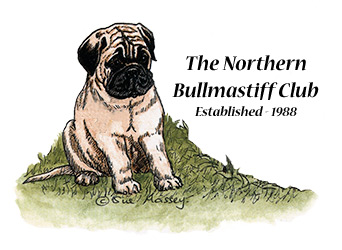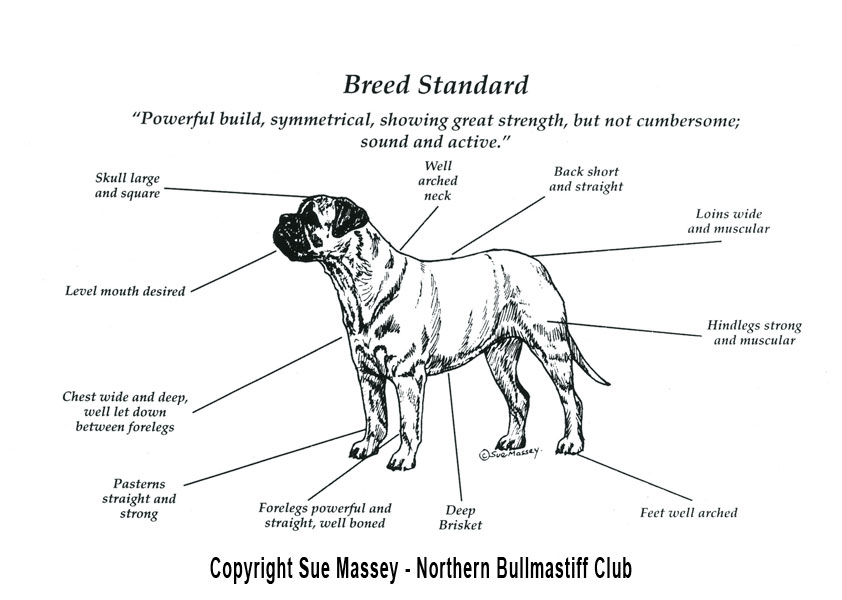Breed Standard
After discussions between the Bullmastiff Breed Council, the Breed Clubs and the Kennel Club regarding the description of Bullmastiff ears, the Bullmastiff Breed Standard was updated in September 2016 and is reproduced below with the permission of the Kennel Club.

Introduction A Breed Standard is the guideline which describes the ideal characteristics, temperament and appearance including the correct colour of a breed and ensures that the breed is fit for function. Absolute soundness is essential. Breeders and judges should at all times be careful to avoid obvious conditions or exaggerations which would be detrimental in any way to the health, welfare or soundness of this breed. From time to time certain conditions or exaggerations may be considered to have the potential to affect dogs in some breeds adversely, and judges and breeders are requested to refer to the Breed Watch section of the Kennel Club website for details of any such current issues. If a feature or quality is desirable it should only be present in the right measure. However if a dog possesses a feature, characteristic or colour described as undesirable or highly undesirable it is strongly recommended that it should not be rewarded in the show ring.

Description
The Bullmastiff comes from the working group of dogs. Over the centuries these dogs were selectively bred to become guards and search and rescue dogs. Arguably, the working group consists of some of the most heroic canines in the world, aiding humans in many walks of life, including the Boxer, Great Dane and St. Bernard. This group consists of the real specialists in their field who excel in their line of work.
The Bullmastiff is a British breed evolved from the Old English Mastiff and the Bulldog. Primarily used as a guard dog and, in olden times, to help the gamekeeper in the apprehension of poachers.
Naturally intelligent and observant, he is easily trained but likes to have a reason for doing things. Highly spirited, he makes a happy companion who is totally reliable both physically and mentally. Devoted to the members of his human family, his bravery and courage in defending them against intruders are legendary. He can quickly assess a situation, and this, combined with his acute hearing, makes him an excellent house-dog. He is very strong, but amenable to kindly discipline.
General Appearance
Powerful build, symmetrical, showing great strength, but not cumbersome; sound and active.
Characteristics
Powerful, enduring, active and reliable.
Temperament
High-spirited, alert and faithful.
Head and Skull
Skull large and square, viewed from every angle, fair wrinkle when interested, but not when in repose. Skull broad and deep with well filled cheeks. Pronounced stop. Muzzle short; distance from tip of nose to stop approximately one-third of length from tip of nose to centre of occiput, broad under eyes and sustaining nearly same width to end of nose; blunt and cut off square, forming right angle with upper line of face, and at same time proportionate with skull. Under-jaw broad to end. Nose broad with widely spreading nostrils; flat, neither pointed nor turned up in profile. Flews not pendulous, never hanging below level of lower jaw.
Eyes
Dark or hazel, of medium size, set apart the width of muzzle with furrow between. Light or yellow eyes highly undesirable.
Ears
V-shaped, folded forward, set on wide and high, level of occiput giving square appearance to skull which is most important. Small and deeper in colour than body. Point of ear level with eye when alert. Rose ears highly undesirable.
Mouth
Level desired but slightly undershot allowed but not preferred. Canine teeth large and set wide apart, other teeth strong, even and well placed.
Neck
Well arched, moderate length, very muscular and almost equal to skull in circumference.
Forequarters
Chest, wide and deep, well let down between forelegs, with deep brisket. Shoulders muscular, sloping and powerful, not overloaded. Forelegs powerful and straight, well boned, set wide apart, presenting a straight front. Pasterns straight and strong.
Body
Back short and straight, giving compact carriage, but not so short as to interfere with activity. Roach and sway backs highly undesirable.
Hindquarters
Loins wide and muscular with fair depth of flank. Hindlegs strong and muscular, with well developed second thighs, denoting power and activity, not cumbersome. Hocks moderately bent. Cowhocks highly undesirable.
Feet
Well arched, cat-like, with rounded toes, pads hard. Dark toenails desirable. Splayed feet highly undesirable.
Tail
Set high, strong at root and tapering, reaching to hocks, carried straight or curved, but not hound-fashion. Crank tails highly undesirable.
Gait/Movement
Movement indicates power and sense of purpose. When moving straight neither front nor hindlegs should cross or plait, right front and left rear leg rising and falling at same time. A firm backline unimpaired by powerful thrust from hindlegs denoting a balanced and harmonious movement.
Coat
Short and hard, weather-resistant, lying flat to body. Long, silky or woolly coats highly undesirable.
Colour
Any shade of brindle, fawn or red; colour to be pure and clear. A slight white marking on chest permissible. Other white markings undesirable. Black muzzle essential, toning off towards eyes, with dark markings around eyes contributing to expression.
Size
Height at shoulder: dogs: 64-69 cms (25-27 ins); bitches 61-66 cm (24-26 ins). Weight: dogs: 50-59 kgs (110-130 lbs); bitches: 41-50 kgs (90-110 lbs).
Faults
Any departure from the foregoing points should be considered a fault and the seriousness with which the fault should be regarded should be in exact proportion to its degree and its effect upon the health and welfare of the dog.
Note
Male animals should have two apparently normal testicles fully descended into the scrotum.
Bullmastiff Colours
Here are a selection of the Bullmastiff colours that are seen in the UK show rings (please note that the images have been taken under different lighting conditions and camera settings; reproduction of colours may also vary depending on your screen).
